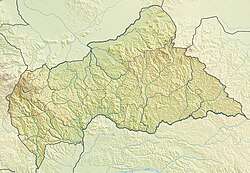
Back Банги Abkhazian Bangui Afrikaans ባንጊ Amharic Bangui AN بانغي Arabic بانجى ARZ Bangui AST Bangui AVK Bangi Azerbaijani بانقی AZB
Bangui
Bangî | |
|---|---|
 From left to right, top to bottom: Oubangui Hotel, shores of Bangui, Bangui Shopping District, pedestrian crossing, view of a street | |
 Bangui | |
Map of the Central African Republic showing Bangui | |
| Coordinates: 04°22′24″N 18°33′46″E / 4.37333°N 18.56278°E | |
| Country | |
| Prefecture | Bangui |
| Founded | 26 June 1889 |
| Government | |
| • Mayor | Émile Gros Raymond Nakombo (2016–present) |
| Area | |
• Total | 67 km2 (26 sq mi) |
| Elevation | 369 m (1,211 ft) |
| Population (2021)[1] | |
• Total | 812,407 |
| • Density | 12,000/km2 (31,000/sq mi) |
| Time zone | UTC+01:00 (West Africa Time) |
| • Summer (DST) | (Not Observed) |
| HDI | 0.420 (1st) |
Bangui (French pronunciation: [bɑ̃ɡi]; or Bangui in Sango, formerly written Bangui in English) is the capital and largest city of the Central African Republic. It was established as a French outpost in 1889 and named after its location on the northern bank of the Ubangi River (French: Oubangui); the Ubangi itself was named from the Bobangi word for the "rapids" located beside the settlement,[2] which marked the end of navigable water north from Brazzaville. The majority of the population of the Central African Republic lives in the western parts of the country, in Bangui and the surrounding area.
The city has been part of Bangui Prefecture since December 2020.[3] As of 2020[update] it had an estimated population of 889,231.
The city consists of eight urban districts (arrondissements), 16 groups (groupements) and 205 neighbourhoods (quartiers). As the capital of the Central African Republic, Bangui acts as an administrative, trade, and commercial centre. The National Assembly, government buildings, banks, foreign enterprises and embassies, hospitals, hotels, main markets and the Ngaragba Central Prison are all located here. Bangui manufactures textiles, food products, beer, shoes and soap. Its Notre-Dame Cathedral is the seat of the Roman Catholic Archdiocese of Bangui. The city is also home to the University of Bangui, inaugurated in 1970. It is served by the Bangui M'Poko International Airport.
- ^ "REGION 7 (GRAND BANGUI)". Institut Centrafricain des Statistiques et des Etudes Economiques et Sociales. 10 June 2022. Archived from the original on 3 June 2023. Retrieved 4 February 2023.
- ^ Room, Adrian. African Placenames: Origins and Meanings of the Names for Natural Features, Towns, Cities, Provinces, and Counties, 2nd ed., p. 30: "Bangui". McFarland & Co., 2008. ISBN 0786435461.
- ^ Oubangui Médias, Oubangui Médias (11 December 2020). "La Centrafrique dispose désormais de 20 préfectures et de 84 sous-préfectures". oubanguimedias.com. Oubangi Medias. Retrieved 27 May 2023.

